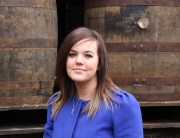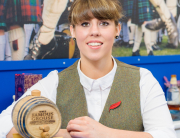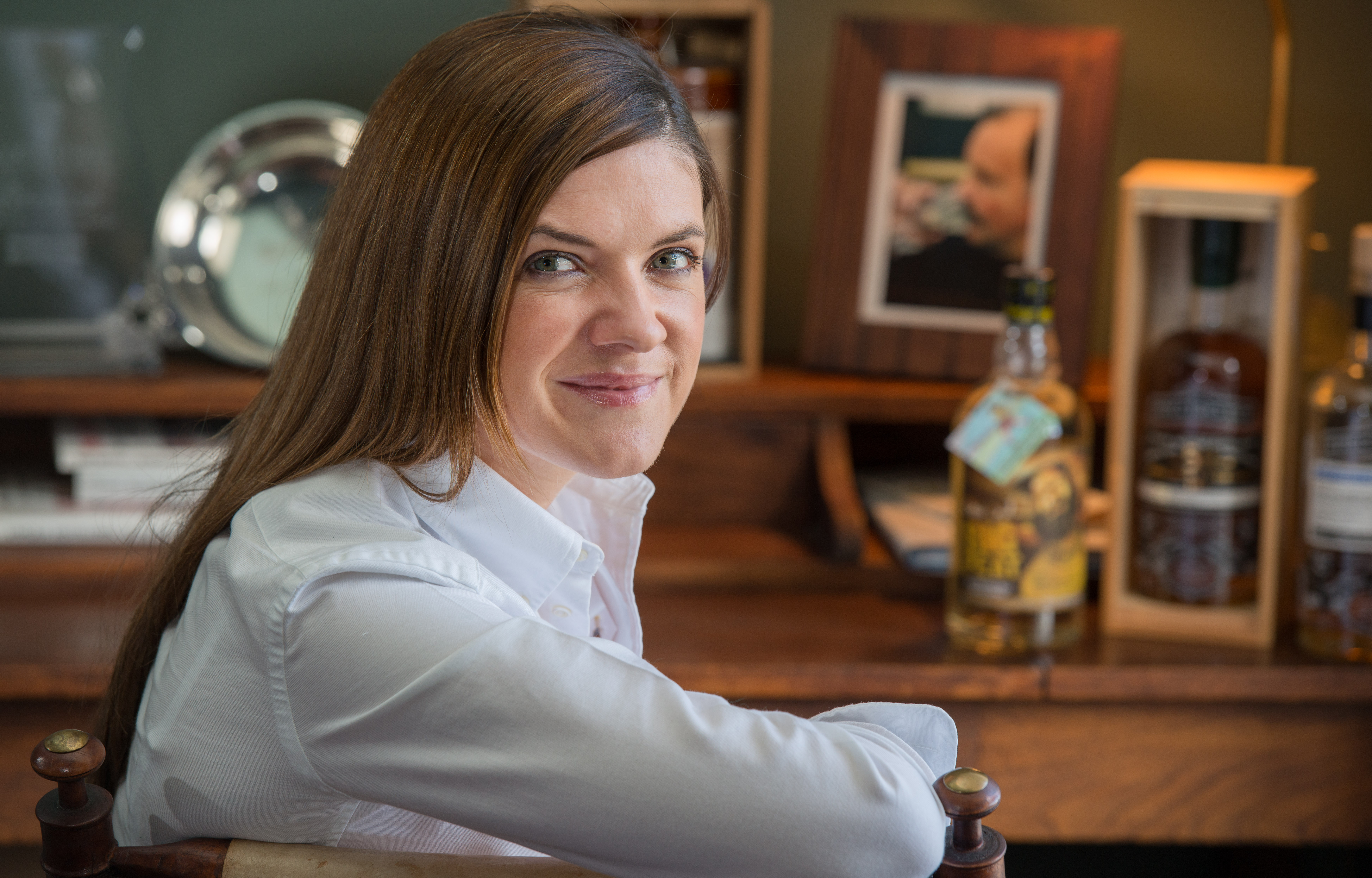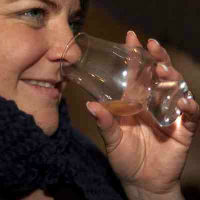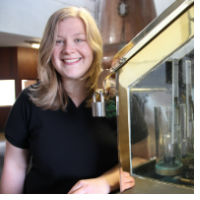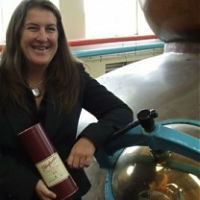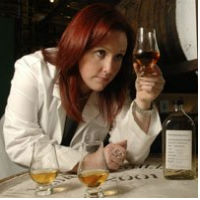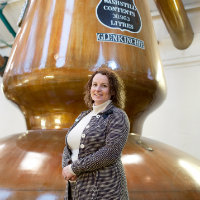“The perception that older is better has been the perception of many. I have always said that ‘a whisky is ready when it is ready’” – Gillian Macdonald
Gillian Macdonald is head of whisky analytics and whisky creation at The Glenmorangie Company where she has worked since 2012.
She was previously the distiller at Penderyn, the only Welsh whisky company.
In this Whisky Women interview, she speaks about her time in the industry, gives her views on non-age statement whisky and discusses Ardbeg…in space!
You were previously the distiller at Penderyn and now you’re up at Glenmorangie as head of analytics and whisky creation – how much different is your role now?
It is different in the sense that I am no longer the person pressing the button or turning the valve at the distillery – but our department works very closely with both Glenmorangie and Ardbeg distilleries and the people that do!
My role now focuses on the sensory aspects of the whole process of creating a whisky from start to finish with the analytical analysis as needed. Our department is responsible for the quality of the malt, process methods, new make spirit, cask purchasing and selection, recipe creation and mature spirit quality control – to ensure that only the best and the highest quality whisky is released.
What do you enjoy most about this role?
The most satisfying part of the job is the freedom to innovate, working with Dr Bill Lumsden to create a whisky for release to the public. We run various trials on bench samples of different recipes in our sensory lab drawing from the amazing range of stock available. Once the final decisions have been made we can then start to let people know about it, which is always a great part – seeing people’s reaction’s as they try the creation for the first time.
You must nose hundreds of samples all of the time: does your nose ever get tired?
I nose a variety of samples for a variety of reasons on a daily basis. Some are quality approvals and this can range from as few as one to six in a day. Other days we can do runs of new-make fresh in from the distilleries and this can include up to 20 samples. For stock analysis and new product development the number of samples can move up to 30-40 a day as we assess individual casks.
Your nose like anything can get fatigued and it is something we are well aware of. We often revisit samples after an initial assessment and also ensure we do not try to limit the number of samples in each session to ensure we working at our optimum. We also run trials of any potential new product through the wider sensory panel – these are people within the company who have been selected from strict criteria to provide feedback. This gives us an indication of what the consumer will think of it.
You originally studied chemistry – do you feel you’ve gone back to your educational roots more in this role?
Yes definitely – I now spend more time dedicated to the whisky process, the chemistry and biochemistry behind the process and the influences on the final result in the glass.
How long do you spend developing a whisky?
As long as it takes – we are very particular about what we are trying to create and do not release the whisky unless we are totally satisfied with the results. Our job is to monitor and track the stock to pick the optimum time for release.
What is one of the most exciting projects you’ve worked on in this role that you’re able to discuss?
I think the Glenmorangie Cask Masters is an excellent opportunity for the whisky lover: innovation is something that Glenmorangie has always been recognised for and this is the first time in our 170 year history that we are giving the consumer the opportunity to step in to our shoes and become a Glenmoranige Cask Master. There are five stages starting with the choice of the whisky from three options, Cask A, B or C, each of which is described in full detail on the website by Dr Bill. The process then moves on to name the limited release design & photograph the look before picking the location for the launch – who would not want to be a part of that?
And of course, Ardbeg…in space, which is a world first! Ardbeg is taking part in an experiment led by US-based space research company NanoRacks LLC to test micro-organic compounds. The maturation experiment will test the interaction of these Ardbeg-crafted molecules with charred oak. This will take place in normal gravity on Earth and also microgravity, far up in space on the International Space Station.
The vials, some of which are currently on the International Space station and others in Warehouse 3 at Ardbeg Distillery, contain a class of compounds known as “terpenes” – a set of chemicals which are very widespread in nature and often very aromatic and flavour-active – as well as other molecules. It is the interaction of these molecules with oak wood that forms the basis of this maturation experiment.
We’re seeing more non-age statement whiskies emerging on the market – do you think this trend will continue and, if so, what are the positives and negatives?
In answer to the first part of the question: yes I believe so! For years ‘age’ has caused mass discussion. The perception that older is better has been the perception of many. I have always said that ‘a whisky is ready when it is ready’ and this is dependent on what flavour profile you are looking for in that particular whisky. Each cask will develop at its own rate and with its own flavours and it is our role to monitor the progression and pluck the cask at its optimum and in its prime and release it from the warehouse. It really comes down to and is dependent upon what style and flavour of whisky you are trying to create. To get some specific flavours you will need the time in the wood and if this is what you are after then that is what you must do. Other flavour may only be present in the early stages of maturation, say for four to six years and will alter, change or disappear with longer periods of maturation. So you need to strike at the correct time to get these specific flavours earlier on in the whisky’s timeline.
There is no hard and fast rule – many other factors come in to play also including the production of the new make spirit – what size and shape of still it has been produced on, what types of condensers are used, the size and position of the spirit cut and then the additional factors that arise in the mashing and fermentation stage. What I do know is the quality of the wood is paramount and to create a great single malt whisky you must use the best available wood and use it in the correct way.
Both Glenmorangie and Ardbeg have whiskies with and without age statement in the ranges – they are all to the exceptional high standard you would expect from both distilleries….the key focus here is quality of the whisky not age in my view.
You are a fantastic example of a ‘Woman in Whisky’! Do you think more women could or should be involved in the industry?
That is very kind of you. If you have the passion and enthusiasm for producing single malt whisky you will be welcomed in to the industry.
What is one of your favourite memories of whisky drinking?
It has to be surrounded by friends and family at the end of my wedding celebrations! Whisky always tastes better in good company!













